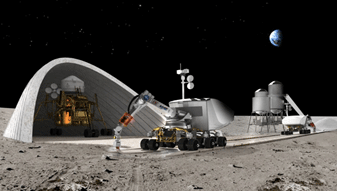About
Welcome to the XO-Structures Research Group!
Here, you can find information pertinent to structural design in low gravity against extra-terrestrial natural hazards with potential applications mainly to the Moon and Mars.
This research group was formed under the project EP/S036393/1 “Designing for the Future: Optimising the Structural Form of Regolith-based Monolithic Vaults in Low-Gravity Conditions” funded by the Engineering and Physical Sciences Research Council (EPSRC), UK.
Material transportation from the Earth to other planetary bodies will be quite costly and would cause severe limitations to the cargo volume. Thus, the further humanity goes into deep space, the more important it will be to rely on local resources. To this end, the widely known in-situ resource utilization (ISRU) framework which suggests utilising indigenous material combined with robotics in order to effectively construct the first ET structures, has gained great momentum. The material in abundance at such harsh environments like the Martian and lunar surface is called regolith. Through specific 3D printing techniques and with the appropriate treatment, regolith may exhibit desirable structural properties and set the stage for the construction of the prospective XO-structures.

The project investigates the behaviour of monolithic, adobe structures in low-gravity conditions, concluding to an optimal structural design framework for supporting future space exploration. Such structures will act as shielding to protect critical assets (such as robots, fuel tanks and power stations) and future inflatable structures (e.g. living quarters) from extreme conditions (radiation, sandstorms, temperature fluctuations) in an extra-terrestrial environment. Linear and nonlinear numerical structural modelling and parametric static and dynamic analyses will identify the optimal design approach for utilising indigenous materials to produce such structures to minimise the weight burden on future manned explorations.
Given the recent and ongoing research on the mechanical properties of regolith simulants, the proposed In-situ Resource Utilisation (ISRU) framework and the advances in 3D printing for extra-terrestrial construction, it is timely to combine these fields with structural design strategies developed for Earth in order to identify optimal structural forms for use in low-gravity conditions, subject to extra-terrestrial dynamic environmental actions.
The main benefit of this project is the establishment of a rigorous structural design framework regarding XO-structures and the identification and categorisation of the extra-terrestrial strong ground motions as a first step for the quantification of the associated hazard.
Aside from the aforementioned objectives related to space exploration and multi-planet habitation, the potential applications of the results from this project can be: (a) the calibration and development of 3D-printing techniques incorporating regolith as a structural material; (b) the sustainable residential development of developing countries using indigenous materials and (c) the optimal seismic design of submarine structures (arches in a global compression state under buoyancy/low gravity) that can prove useful for deep-ocean exploration and mining.

